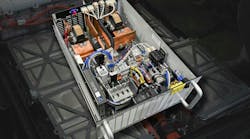Major differences exist between a PIN photodiode and an avalanche photodiode (APD), such as:
- Gain isn’t provided in a PIN photodiode; however, high gain and high speed via an internal gain mechanism is provided in an APD.
- An undoped intrinsic layer is strategically placed between two highly doped regions in a PIN diode, whereas a π layer is positioned between a p and n region in an APD.
- An amplifier is necessary to connect externally for a PIN diode, but no external amplifier is needed in an APD.
- A PIN diode has less response time, while an APD offers a very fast response time.
- PIN diodes have a small output current; APDs have higher output current.
- In a PIN diode, different noise currents are photon noise, shot noise, Johnson noise, and generation recombination noise. APDs have different noise currents such as shot noise, thermal noise, and avalanche noise.
- PIN diodes have shot current of Ishot = √2qIDB; APDs have shot current of Ishot = √2q (Iph + IB + ID)G2FB.
- PIN diodes have less sensitivity, while APDs possess higher sensitivity to detect very low light levels.
- PIN diodes need a low reverse bias; APDs require high reverse bias.
- PIN diodes have good temperature stability; APDs have poor stability.









